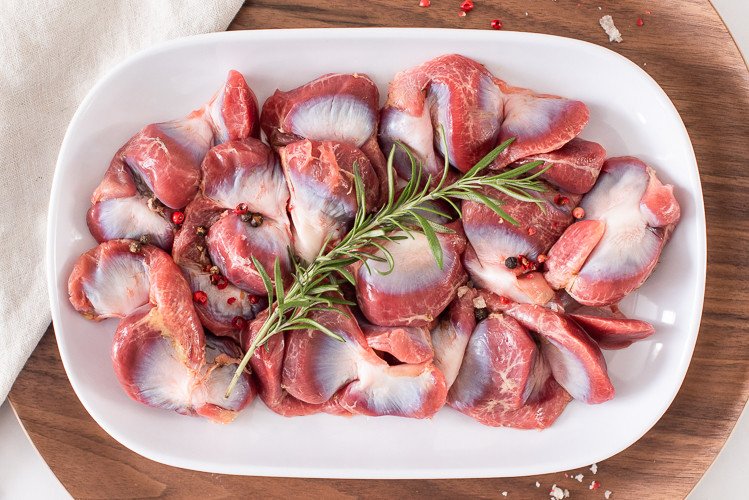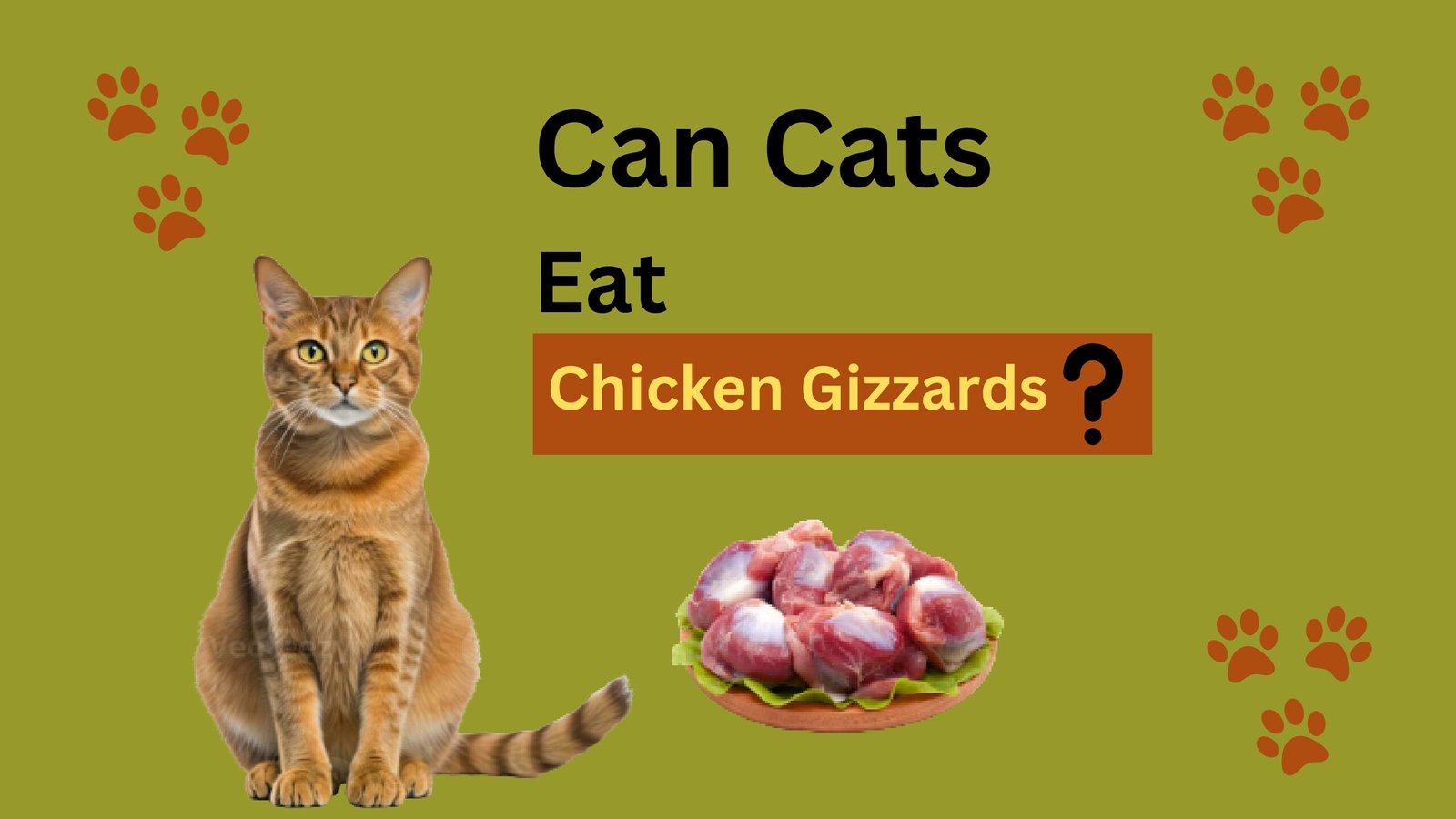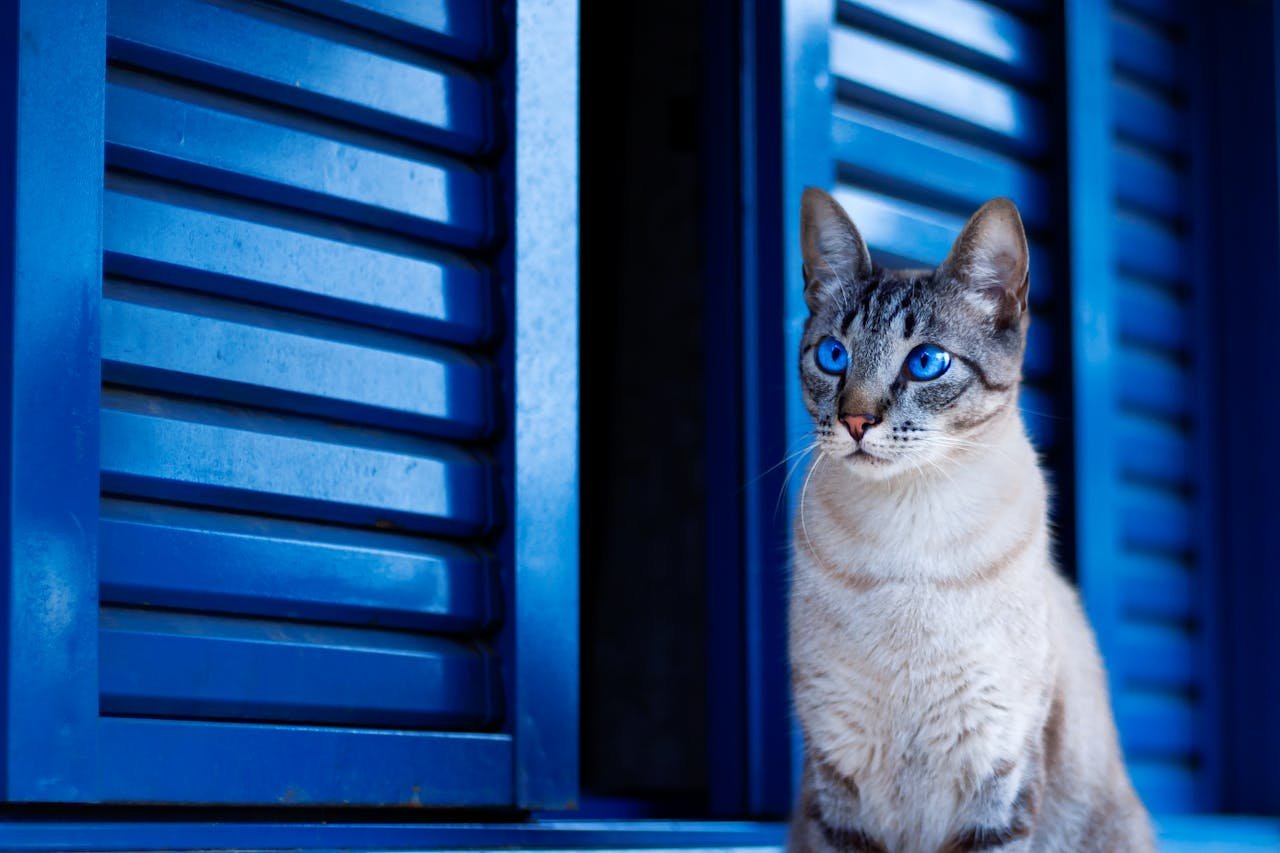Can Cats Eat Chicken Gizzards Safely in 2025? Hidden Dangers Every Cat Owner Should Know
In 2025, as the pet wellness industry continues to shift toward natural, whole-food remedies, chicken gizzards have become a popular option for cat owners seeking joint care solutions without relying on synthetic processing, pills, or powders. These nutrient-dense organ meats offer a natural way to enhance your cat’s diet while supporting their overall health. According to 2025 veterinary nutrition guidelines, the answer to the question “Can cats eat chicken gizzards?” is a confident yes. When properly prepared and fed in moderation, chicken gizzards can be a highly beneficial addition to your cat’s meal plan. They are rich in taurine, protein, iron, and other essential nutrients that support heart function, muscle strength, and the overall wellness of obligate carnivores like cats. Chicken gizzards are also gentle on your cat’s teeth and easy to prepare. However, they should be offered only occasionally—ideally 1 to 2 times per week—and never as a standalone meal. Since they lack the complete nutrient profile required for daily feline health, they work best as a supplement to a balanced diet. To ensure your cat’s safety, always serve gizzards cooked without seasoning, or raw only under strict veterinary-approved hygiene protocols. So, if you’ve been wondering, “Can cats eat chicken gizzards?”—the answer is yes, as long as it’s done correctly and responsibly in today’s modern pet nutrition landscape.
What Are Chicken Gizzards?
Chicken gizzards are tough, muscular organs found in a chicken’s digestive system, located between the crop and the stomach. As chickens don’t have teeth, they instinctively swallow small bits of grit, sand, and gravel, which travel down their digestive tract and accumulate in the gizzard. This natural grit acts like a grinding tool inside the gizzard, helping break down hard food into smaller, more digestible particles before it moves to the small intestine for nutrient absorption. The gizzard itself is densely fibrous and rich in lean protein, iron, and other vital nutrients—making it not only an essential part of the chicken’s anatomy but also a nutrient-packed organ meat valued in both human and animal nutrition. In pet diets, especially for cats, gizzards are praised for their high biological value, offering a natural source of taurine and protein while mimicking what felines would consume in the wild. Understanding the function and makeup of chicken gizzards is key to appreciating their role in both poultry digestion and species-appropriate pet feeding in 2025.

Why Is It Good for Cats to Eat Chicken Gizzards?
Feeding chicken gizzards to cats is an excellent way to support their carnivorous dietary needs with a nutrient-dense, biologically appropriate food source. As obligate carnivores, cats thrive on protein-rich diets, and chicken gizzards deliver precisely that—along with a natural supply of vitamin B12, iron, phosphorus, and taurine, all essential for your cat’s heart health, muscle development, and daily energy. Gizzards are especially beneficial because they provide lean, easily digestible protein without excessive fat, making them ideal for both active and senior cats. However, it’s crucial to prepare them correctly: gizzards should always be cooked slowly with moist heat to eliminate harmful bacteria without destroying their nutritional value. Avoid high temperatures or seasoning, and never serve them raw unless you’re following a veterinary-approved raw feeding plan. While gizzards may not be as aromatic as liver or heart, combining them with small amounts of liver can enhance the flavor and turn them into a gourmet treat your feline companion will love. In 2025, as more cat parents embrace ancestral feeding approaches, chicken gizzards stand out as a safe, wholesome, and natural addition to your cat’s weekly menu.
What Nutrients Are in Chicken Gizzards?
Chicken gizzards are a powerhouse of nutrition, especially valuable for carnivorous pets like cats. As a type of organ meat, they offer a lean, protein-rich, and low-fat profile that supports everything from muscle growth to immune function. Naturally free from carbohydrates and low in calories, chicken gizzards are ideal for cats needing a high-protein, species-appropriate diet. According to the latest USDA data, a 100-gram serving of chicken gizzards contains approximately 17.7 grams of protein, 94 calories, 2 grams of fat, and zero carbohydrates. But the benefits go beyond macros—gizzards are also an excellent source of vital micronutrients like iron (for oxygen transport and energy), zinc (for skin, coat, and immune support), and vitamin B12 (for neurological health and red blood cell production). In 2025’s era of informed pet nutrition, chicken gizzards shine as a functional, nutrient-dense food that not only meets but enhances a cat’s natural dietary needs when served correctly and in moderation.
Related Post: Can Cats Eat Jell-O in 2025? What You Should Know
The Undeniable Benefits of Chicken Gizzards for Cats in 2025
Why Chicken Gizzards Are a Feline Superfood
In today’s evolving world of pet nutrition, more cat owners are asking, can cats eat chicken gizzards—and the answer is a resounding yes. As obligate carnivores, cats depend on animal-based proteins to thrive, and chicken gizzards are emerging as a superior, biologically appropriate food choice. These tough, muscular organs, located in a chicken’s digestive tract, are naturally high in protein, low in fat, and completely free from carbohydrates. This macronutrient profile supports lean muscle development, energy production, and healthy skin and coat. In a world where feline obesity and digestive sensitivities are on the rise, chicken gizzards offer a clean, natural protein source that caters to your cat’s primal dietary instincts.
Packed With Nutrients Your Cat Can’t Thrive Without
What sets chicken gizzards apart is their dense concentration of essential micronutrients. For cats to maintain optimal health, they require more than just protein—they need a consistent intake of vitamins and minerals, many of which are found in abundance in chicken gizzards. These include iron, which is crucial for the formation of hemoglobin and the transport of oxygen in the blood; selenium, a potent antioxidant that protects cells from oxidative damage; magnesium, essential for enzyme activity and energy metabolism; and vitamin B12, vital for neurological function, appetite regulation, and cellular energy production. Whether you’re feeding a growing kitten, a senior cat, or a recovering feline, gizzards offer a rich, nutrient-packed option without relying on synthetic additives or fillers.
Natural Joint Support From Glucosamine
One of the most overlooked yet powerful benefits of chicken gizzards for cats is their natural content of glucosamine—a compound often found in expensive feline joint supplements. As your cat ages, joint wear and inflammation can affect mobility and comfort. Glucosamine supports joint health by reducing inflammation, aiding cartilage regeneration, and improving joint lubrication. The beauty of chicken gizzards is that they deliver this compound in its most natural, bioavailable form—without
Unlike hard kibble or raw bones, chicken gizzards for cats offer a satisfying chew without risking dental injury. Their semi-tough yet pliable texture encourages jaw movement and supports gum stimulation, making them a great addition to your cat’s dental health routine. They are especially suitable for cats with sensitive teeth or dental conditions that prevent them from handling bones. Preparation is simple yet critical: gizzards should always be cooked thoroughly—boiled or steamed without seasoning—to eliminate harmful pathogens like Salmonella or E. coli while preserving nutrient density. When prepared correctly, chicken gizzards become a flavorful, easy-to-digest meal that even finicky cats find irresistible. For added appeal, you can mix in a small portion of chicken liver, which not only enhances taste but adds extra vitamins and minerals.
Can Cats Eat Chicken Gizzards Safely? Risks Every Cat Parent Must Consider in 2025
Chicken gizzards are a protein-rich organ meat that many cat owners consider feeding their pets due to their nutritional benefits. However, while they’re safe for healthy felines in moderation, there are some potential health concerns you must be aware of before adding gizzards to your cat’s diet. So, can cats eat chicken gizzards safely? Let’s explore the risks in detail.
Not Ideal for Cats with Kidney or Renal Problems
Although chicken gizzards are nutrient-dense, they are naturally high in phosphorus, which can be problematic for cats with kidney issues. Elevated phosphorus levels can strain the kidneys, potentially worsening renal conditions. If your cat has been diagnosed with kidney disease or is on a low-phosphorus diet, it’s essential to consult your veterinarian before including gizzards in their meal plan.
High in Cholesterol: A Hidden Concern
One lesser-known fact about chicken gizzards is their high cholesterol content. This makes them unsuitable for cats that are overweight, have a history of heart disease, or suffer from liver complications. Even if your cat is healthy, regular intake of high-cholesterol foods can contribute to long-term cardiovascular risks. Moderation and veterinary guidance are crucial when introducing gizzards as an occasional treat.
Not a Complete Meal: Nutritional Limitations
While chicken gizzards are packed with protein, iron, and vitamin B12, they do not provide all the essential nutrients cats need, such as taurine, calcium, and certain fatty acids. They should only be a small part of a well-balanced feline diet and never used as a staple or meal replacement.
Risks of Feeding Raw Chicken Gizzards

Raw chicken gizzards can harbor dangerous bacteria like Salmonella and Campylobacter, which may lead to serious digestive upset, including vomiting, diarrhea, and fever. These bacterial infections pose a risk to both cats and their human companions. For safety, always cook chicken gizzards thoroughly before offering them to your cat, and avoid feeding raw unless you’re following a vet-approved raw diet plan.
Potential for Allergic Reactions or Food Sensitivities
Though rare, some cats may exhibit allergic reactions to chicken or poultry-based products, including gizzards. Symptoms may include vomiting, itching, dizziness, or diarrhea. If you notice any unusual behavior or signs after introducing chicken gizzards, discontinue feeding immediately and consult your vet.
How to Prepare Chicken Gizzards for Cats Safely in 2025
If you’re considering feeding chicken gizzards to your cat, preparation is everything. While raw feeding has gained popularity in some feline diets, it’s not without risk. Gizzards can carry harmful pathogens like Salmonella, Campylobacter, and parasites such as Toxoplasma gondii. Therefore, the safest method is to cook chicken gizzards thoroughly before serving them to your feline friend.
Why Cooking Chicken Gizzards Is Essential
Though cats are natural carnivores, domesticated pets are not equipped to handle the same bacterial load that wild cats may encounter in raw meat. Cooking chicken gizzards not only eliminates potential pathogens but also softens the dense muscular tissue, making it easier for your cat to chew and digest. Cooked gizzards can be an excellent supplemental treat when served in moderation as part of a balanced feline diet.
Cleaning and Prepping Chicken Gizzards Before Cooking
Before you cook chicken gizzards for your cat, cleaning is a critical first step. Gizzards are essentially muscular organs that help birds grind food, and they often contain dirt or grit. Here’s how to clean them properly:
- Rinse each gizzard thoroughly under cold running water to remove any visible debris or residue.
- Cut the gizzard open and discard any tough white membrane or remaining grit inside.
- Remove any attached fat or gristle.
- Slice the cleaned gizzards into small, bite-sized pieces to make chewing easier and to prevent choking, especially for smaller or older cats.
Proper cleaning ensures the safety and palatability of the gizzards, turning a tough organ meat into a digestible and nutritious snack.
Cooking Method: How to Boil Chicken Gizzards for Cats
Boiling is one of the safest and most effective methods for preparing chicken gizzards for cats. Follow this simple step-by-step guide:
- Place the cleaned, chopped gizzards into a medium-sized pot.
- Fill the pot with enough water to fully submerge the meat.
- Bring the water to a rolling boil over medium-high heat.
- Once boiling, reduce the heat and let it simmer for about 20 to 25 minutes, or until the gizzards are fully cooked and tender.
- Remove the gizzards from the pot and allow them to cool completely before serving.
- Store any leftovers in an airtight container in the refrigerator for up to three days, or freeze them in small portions for future use.
Avoid using oil, salt, garlic, onions, or seasonings during the cooking process. These additives are harmful to cats and can lead to digestive upset or toxic reactions.
Portion Control and Serving Tips
Once cooked and cooled, chicken gizzards can be offered as a treat or mixed with your cat’s regular food. However, moderation is crucial. Gizzards should never replace your cat’s complete and balanced diet. Instead, use them as a protein-rich supplement, perhaps once or twice a week. Always monitor your cat for any adverse reactions when introducing new proteins.
Related Post: Can Cats Eat Cheerios? Expert Advice 2025
Final Thoughts: Can Cats Eat Chicken Gizzards in 2025?
So, can cats eat chicken gizzards in 2025? Absolutely—yes, and with great benefits. When prepared correctly, chicken gizzards aren’t just a filler or occasional treat; they are a nutrient-dense, protein-rich superfood that aligns with your cat’s natural dietary needs.
From boosting muscle development to delivering essential minerals like iron and selenium, chicken gizzards offer a biologically appropriate and cost-effective way to support your feline’s long-term health. Add in the natural glucosamine for joint support and a texture that promotes better oral hygiene, and it’s clear—this humble organ meat packs a punch.
However, proper preparation is the golden rule. Always cook gizzards thoroughly to eliminate harmful bacteria and serve them in moderation, alongside a complete and balanced diet.
In a world where cat parents are more conscious than ever about what goes into their pet’s bowl, chicken gizzards emerge as a smart, science-backed choice for 2025. If you’re looking to elevate your cat’s nutrition naturally, this is one powerful protein source you shouldn’t overlook.
Because when it comes to your cat’s health, nature still knows best.
Frequently Asked Questions About Chicken Gizzards for Cats
Can cats eat raw chicken gizzards?
While some raw feeders include raw gizzards in their cat’s diet, it’s not recommended for the average pet owner due to the risk of harmful bacteria like Salmonella and Campylobacter. Cooking chicken gizzards is a much safer option and still retains most of the nutrients.
Are chicken gizzards good for cats?
Yes, chicken gizzards are incredibly nutritious for cats. They’re packed with high-quality protein, iron, zinc, and B vitamins. When served in moderation and properly cooked, gizzards can support muscle health, immunity, and energy levels.
How often can I give my cat chicken gizzards?
Chicken gizzards should be offered as an occasional treat or supplement, not a daily meal. Overfeeding can lead to nutritional imbalances or excessive cholesterol. A few pieces once or twice a week is typically safe for healthy cats.
Can kittens eat chicken gizzards?
Kittens can eat chicken gizzards in small, well-cooked portions, once they’re fully weaned. However, because kittens have sensitive stomachs and rapidly changing nutritional needs, it’s best to consult your vet before adding organ meats to their diet.
Do chicken gizzards help clean cats’ teeth?
Yes! Chicken gizzards have a tough texture that can naturally help remove plaque and tartar as your cat chews. While not a replacement for dental care, they can be a natural aid for oral hygiene.
Can cats with kidney disease eat chicken gizzards?
Not recommended. Chicken gizzards are high in phosphorus, which can worsen kidney problems. If your cat has renal issues, always consult your veterinarian before introducing any new protein source, including organ meats.
Should I remove the white membrane from the gizzard?
Yes. The tough white membrane can be hard for cats to chew and digest. It’s best to remove it before cooking to make the gizzards more palatable and safer for your cat.
For More Visits: SiameseMania
Also Read: Can Cats Have Mandarin Oranges? Expert Warnings 2025

